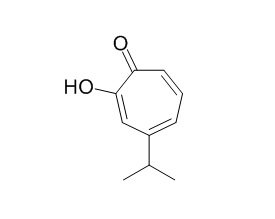Hinokitiol
Hinokitiol has antibacterial effect , it can inhibit all Staphylococcus aureus isolates with MICs of 1.56-3.13 mg/L, it also has antifungal activity against 51 Malassezia pachydermatis strains, it is an inexpensive and safe treatment with anti-inflammatory and deodorant effects that can be recommended as an effective remedy for canine otitis externa. beta-thujaplicin (Hinokitiol) has ability to extract mitochondrial Mg and the prevention of the effects of beta-thujaplicin by an excess of Mg in the medium, suggests a common mode of action of beta-thujaplicin as a lipophilic chelator of Mg and other divalent cations.
Inquire / Order:
manager@chemfaces.com
Technical Inquiries:
service@chemfaces.com
Tel:
+86-27-84237783
Fax:
+86-27-84254680
Address:
1 Building, No. 83, CheCheng Rd., Wuhan Economic and Technological Development Zone, Wuhan, Hubei 430056, PRC
Providing storage is as stated on the product vial and the vial is kept tightly sealed, the product can be stored for up to
24 months(2-8C).
Wherever possible, you should prepare and use solutions on the same day. However, if you need to make up stock solutions in advance, we recommend that you store the solution as aliquots in tightly sealed vials at -20C. Generally, these will be useable for up to two weeks. Before use, and prior to opening the vial we recommend that you allow your product to equilibrate to room temperature for at least 1 hour.
Need more advice on solubility, usage and handling? Please email to: service@chemfaces.com
The packaging of the product may have turned upside down during transportation, resulting in the natural compounds adhering to the neck or cap of the vial. take the vial out of its packaging and gently shake to let the compounds fall to the bottom of the vial. for liquid products, centrifuge at 200-500 RPM to gather the liquid at the bottom of the vial. try to avoid loss or contamination during handling.
Biomed Pharmacother.2024, 181:117647.
Biol Pharm Bull.2018, 41(1):65-72
J of L. Chroma.&Related Tech2017, 252-258
Int J Med Sci.2020, 17(5):626-631
Separations2021, 8(7),90.
Eur Rev Med Pharmacol Sci.2020, 24(9):5127-5139.
Horticulture Research2020, 7:111.
Virus Res.2023, 335:199199.
Neurochem Int.2018, 121:114-124
Acta Physiologiae Plantarum2016, 38:7
Related and Featured Products
J. Antimicrob. Chemoth., 2003, 51(1):113-22.
Antibacterial effect of β-thujaplicin on staphylococci isolated from atopic dermatitis: relationship between changes in the number of viable bacterial cells and clinical improvement in an eczematous lesion of atopic dermatitis[Pubmed:
12493795]
beta-Thujaplicin (Hinokitiol) is a tropolone-related compound purified from the wood of Chamaecyparis obtusa, Sieb. et Zucc. and Thuja plicata D. Don.
METHODS AND RESULTS:
All Staphylococcus aureus isolates were inhibited by beta-Thujaplicin with MICs of 1.56–3.13 mg/L. However, a paradoxical zone phenomenon occurred, with each isolate producing regrowth at higher β-thujaplicin concentrations. Other antimicrobial agents showed a wide range of MICs. The combination of beta-Thujaplicin and zinc oxide inhibited the paradoxical zone phenomenon, and enhanced killing activity against clinically isolated staphylococci. Large numbers of viable bacterial cells, especially S. aureus cells, were detected in the skin surface of atopic dermatitis, in comparison with those in healthy volunteers. The number of cells increased as the severity of the skin condition worsened. Topical application of β-thujaplicin resulted in a reduction in the number of bacterial cells on the skin surface, and an improvement in skin condition after treatment.
CONCLUSIONS:
The results of this study suggest that the degree of reduction in the number of viable bacterial cells in an eczematous lesion of atopic dermatitis is related to the degree of improvement in skin condition.
J. Vet. Med. Sci., 2005, 67(12):1243-7.
Effects of beta-thujaplicin on anti-Malassezia pachydermatis remedy for canine otitis externa.[Pubmed:
16397383]
The antifungal activity of beta-thujaplicin(Hinokitiol) was evaluated against 51 Malassezia pachydermatis strains isolated from canine ear canals with or without otitis externa.
METHODS AND RESULTS:
For comparison, sensitivity tests were performed on M. pachydermatis isolates for nystatin, ketoconazole, and terbinafine HCl, all clinically available antifungal agents.
The minimal inhibition concentrations over 50% of the tested isolates (MIC50) were 3.13 microg/ml for beta-thujaplicin and nystatin, 0.016 microg/ml for ketoconazole, and 1.56 microg/ml for terbinafine HCl. The antifungal effect for M. pachydermatis of beta-thujaplicin compared favorably with commercial antifungal agents. None of the 51 M. pachydermatis isolates showed resistance against any of the tested antibiotics investigated in this study. Ten representative isolates of M. pachydermatis were subcultured for 30 generations at concentrations close to the MIC levels of beta-thujaplicin, nystatin, ketoconazole, and terbinafine HCl, and examined to determine whether they had acquired resistance to each drug. As a result, M. pachydermatis was found to achieve resistance more easily for ketoconazole and terbinafine HCl than for beta-thujaplicin or nystatin.
The MIC50 of beta-thujaplicin did not change during the course of subculture, and it is thought that the potential development of a resistant strain is low, even with continuous infusion for otitis externa therapy.
CONCLUSIONS:
beta-Thujaplicin(Hinokitiol) is an inexpensive and safe treatment with anti-inflammatory and deodorant effects that can be recommended as an effective remedy for canine otitis externa.



